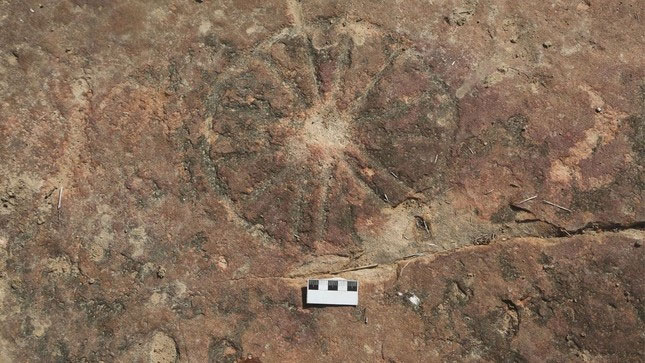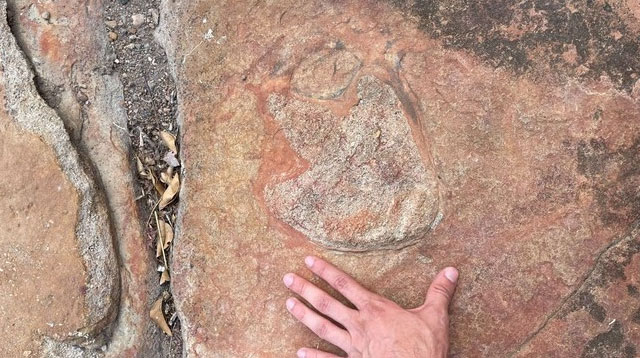Discovering a 9,000-year-old work of art next to dinosaur footprints
A new study shows that 9,400 years ago, hunter-gatherers in what is now Brazil created dozens of stunning rock art designs alongside fossilized dinosaur footprints.

The petroglyphs were discovered at an archaeological site in Brazil. (Photo: Leonardo Troiano)
Researchers have described petroglyphs and dinosaur tracks dating back to the Cretaceous period (145 million to 66 million years ago), in a study just published in the journal Scientific Reports. They suggest that ancient humans deliberately placed rock art next to dinosaur footprints, as many of the petroglyphs were only 5 to 10 centimeters away from the fossil prints.
Study first author Leonardo Troiano, an archaeologist from Brazil's National Institute of Historical and Artistic Heritage, said: 'The individuals who created the petroglyphs were acutely aware of the footprints,' said the study's first author Leonardo Troiano, an archaeologist from Brazil's National Institute of Historical and Artistic Heritage. have the ability to choose the exact location'.
The archaeological site is called Serrote do Letreiro (Portuguese for "Signpost Hill") , about 11 km from the urban center of Sousa in the northeastern state of Paraíba. It is located near Dinosaur Valley, a reserve famous for its hundreds of fossilized dinosaur footprints.
Researchers have known about fossilized dinosaur footprints in the area since the early 20th century, but rock art there has been mentioned only briefly over the years, the new study says. Although there has been knowledge of at least one ancient engraving by the Kiriri people, the main indigenous group in northeastern Brazil, the closeness between the petroglyphs and dinosaur tracks has never been known, Troiano said. Be recorded.
Dinosaur footprints from many different species

Dinosaur footprints.
Troiano and colleagues conducted research with a group of middle school students who visited the site in 2023. In addition to learning about paleontology and archaeology, the students also took field research photos .
The site contains dinosaur footprints from many different mammals, including theropods, sauropods and ornithopods.
The team noted that the tracks were from many different types of dinosaurs , such as carnivorous theropods, long-necked sauropods and bipedal ornithopods, including iguanodontians.
The study authors suggest that the similarity of dinosaur footprints to those of the ostrich Rhea americana, the largest living bird in Brazil, may have helped ancient people recognize and explain these relics. This fossil record is easier.
The petroglyphs, which are largely circular carvings filled with lines and other geometric features, are believed to have been created by humans who lived in the area between about 9,400 and 2,620 years ago. 'They were small groups of hunters and gatherers who lived in societies and used objects made from stone,' says Troiano .
The researchers did not find any organic remains that could help with radiocarbon dating, so they compared the artwork to archaeological sites in the area with the artwork. Similar or identical stone art.
For example, petroglyphs at sites such as Pedra do Alexandre, about 200km west of Serrote do Letreiro, are dated to around 9,400 years ago, based on radiocarbon analyzes of human graves .
Researchers found that ancient humans created the newly described carvings using two techniques: punching and scraping.
'Perforating involves using a type of stone hammer to create indentations in the surface,' says Troiano, while scraping entails rubbing a stone against the surface until it forms the desired engraving. want. In some cases, both techniques are combined to enhance visibility and depth" .
- Series of dinosaur footprints revealed after storm in England
- Detecting dinosaur footprint 70 million years old
- Discover the smallest dinosaur footprint ever
- Discovered giant dinosaur footprints in Scotland
- Jurassic dinosaur vestige found in southwestern China
- Carnivorous dinosaur footprints on Australian beach
- Discovered 300 dinosaur footprints in China
- Discovered rare dinosaur footprints 170 million years ago
- Discover cliffs with more than 5,000 ancient dinosaur footprints
- Go to Australia to try on the dinosaur footprint
- Discovering the dancer's dancer
- Discovered several hundred dinosaur footprints in Beijing
 Discovered an ancient centipede fossil 99 million years old
Discovered an ancient centipede fossil 99 million years old Discovered bat-like dinosaurs in China
Discovered bat-like dinosaurs in China Discovered a 200-year-old bronze cannon of the coast
Discovered a 200-year-old bronze cannon of the coast Discover 305 million-year-old spider fossils
Discover 305 million-year-old spider fossils